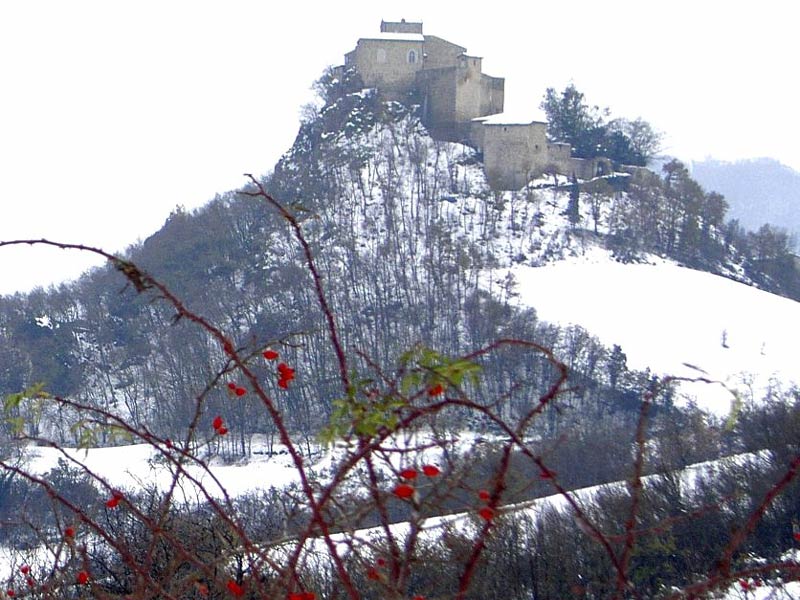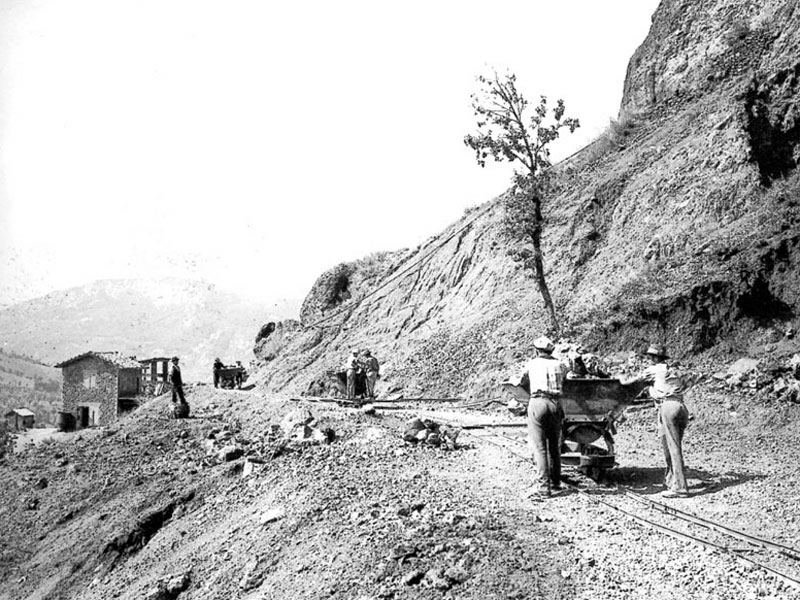Riserva Naturale Orientata Rupe di Campotrera
www.parchiemiliacentrale.itProtected Area
Identity Card
- Land Surface Area: 41.85 ha
- Lower altitude (m): 275
- Higher altitude (m): 446
- Regions: Emilia Romagna
- Provinces: Reggio Emilia
- Municipalities: Canossa
- Establishment Measures: DCC 1268 13/10/1999
- PA Official List: EUAP1157
- Park Authority: Ente di gestione per i Parchi e la Biodiversità Emilia Centrale
Origin and Features of the Cliff
Like the other ophiolites present in the region, the Rupe (meaning "cliff", 450m) is a rocky fragment created about 170 million years ago by the emission of magma at the bottom of the ancient Ligurian-Piedmontese Ocean. After the Apennine orogenesis, the Upper Cretaceous stretches of ocean crust were submerged by clay and transported for many kilometers before emerging again in the hills and mountains of Emilia, where they stand out today in the landscape for the greater resistance to erosion.
Rossena Basalt
The Cliff represents the most imposing rocky outcrop around Rossena Castle, where a dozen of ophiolitic mountains can be found. It is formed by basaltic rocks with a characteristic reddish color given to the oxidation of ferromagnesian compounds, from which the place name Rossena derives. In Emilia, the ophiolites situated at a greater distance from the Apennine chain mainly consist of dark greenish serpentinites; the basalt of Campotrera is an exception of great geological interest.
Datolite Crystals
A quarry of volcanic rock which was active until forty years ago has opened a large rocky front on the Cliff. Subsequent researches have led to the discovery of a rich list of minerals, sometimes particularly rare ones like the datolite - typical of the ophiolites - which is present in the reserve with crystalline formations of great beauty, often set in veins with prehnite and calcite (some beautiful crystals are preserved in Rossena Castle). Other rather interesting minerals linked to the basalt are analcime and natrolite.
The Unique Vegetable World of the Ophiolites
The particular chemical nature of the substratum, poor in nourishing substances and with high concentrations of iron, magnesium, and nickel, as well as the high temperature the rock can reach under the rays of the sun, transform the ophiolites in one of the most selective places for the flora, with different rare or exclusive species.
In the fissures of the sunny walls, succulent plants of the genus Sedum and the fleshy rosettes of Sempervivum tectorum grow, while in the most shadowy corners delicate ferns survive. On the rocky detritus and on eroded clays at the border of the reserve, alternating with Downy oak woods, there are rare species like Feather Grass, Burning Bush, Autumn Squill and Camphorosma monspeliaca, a dwarf shrub with an intense aroma. Barlia robertiana is probably the rarest among the orchids of the reserve, where we can also find Ophrys sphegodes, Ophrys bertolonii, Orchis provincialis, Orchis simia and Himantoglossum adriaticum. A curiosity is represented by the Prickly Pear, a naturalized American species which can be found along the rocky walls of the trail climbing to Rossena Castle.
Fauna
The diversity of environments present in the Reserve favors the
presence of a good variety of animal species, in particular as far as
avifauna is concerned.
Within the area there are 4 bird species.
At the moment, 5 amphibian species have been found: the Common Newt (Triturus vulgaris), the Crested Newt (Triturus carnifex), the Tree Frog (Hyla intermedia), the Edible Frog (Rana esculenta complex), the Common toad (Bufo bufo).
Among reptiles, the Green Lizard (Lacerta viridis), the Three-toed skink (Chalcides chalcides), the Green Snake (Coluber viridiflabus), the Grass Snake (Natrix natrix), and the Viper (Vipera aspis).
At the moment, 56 bird species have been signalled, out of which 29
nesting species, 5 wintering species, 10 present only when migrations
take place.
On the rocky walls of the Reserve we can see Kestrels, Jackdaws, Common Redstarts, Black Redstarts, Wallcreepers.
The Peregrine was also sighted near the cliff in the past.
Several species of birds can be found in the woods and shrubby areas of
the Reserve: Sparrow Hawks, Great Spotted Woodpeckers, Woodpigeons,
Hoopoes, Long-tailed Tits, Nightjars, Cuckoos, Olivaceous Warblers,
Common Whitethroats, Hawfinches, Red-backed Shrikes, and Fieldfares.
The presence of several shrubs covering the abandoned cultivated fields
or the edges of the wood is very important for the avifauna, since many
species find here food and shelter.
Grasslands and cultivated fields are characterized by the presence of
nocturnal and diurnal birds of prey and by small passerines (Serin,
Spotted Flycatcher, Yellowhammer, and Ortolan Bunting).
Some important species of the avifauna nest among the high grass of the
grasslands and abandoned fields (Corn Bunting, Skylark, Woodlark, and
Tree Pipit), and find here a habitat which is elsewhere rare.
Among the ungulates, in the Reserve you can find the Roe Deer (Capreolus capreolus) and the Wild Boar (Sus scrofa), while the Fallow Deer (Dama dama) is not very widespread.
Among carnivorous animals, the fox (Vulpes vulpes), the Stone Marten (Martes foina), the Badger (Meles meles), and the Weasel (Mustela nivalis).
The
area is characterized by the presence of several places working as a
shelter for chiropters (bats), both on the cliff and in the wood.
The Species and Habitats of Community Importance
The Site of Community Importance - SCI: Rupe di Campotrera - Rossena
The reserve is situated within the Site of Community Importance "SCI Rupe di Campotrera - Rossena", covering an area of 817 hectares.
Established for the presence of 4 bird species (Nightjar-Caprimulgus europaeus, Woodlark-Lullula arborea, Red-backed Shrike-Lanius collurio and Ortolan Bunting-Emberiza hortulana)
listed in attachment 1 of the Directive 79/409/CEE regarding the
protection of wild avifauna and habitats according to what established
by attachment 1 of the Habitat Directive 92/43/CEE, mainly
linked to the rocky and arid environments of the Reserve.











